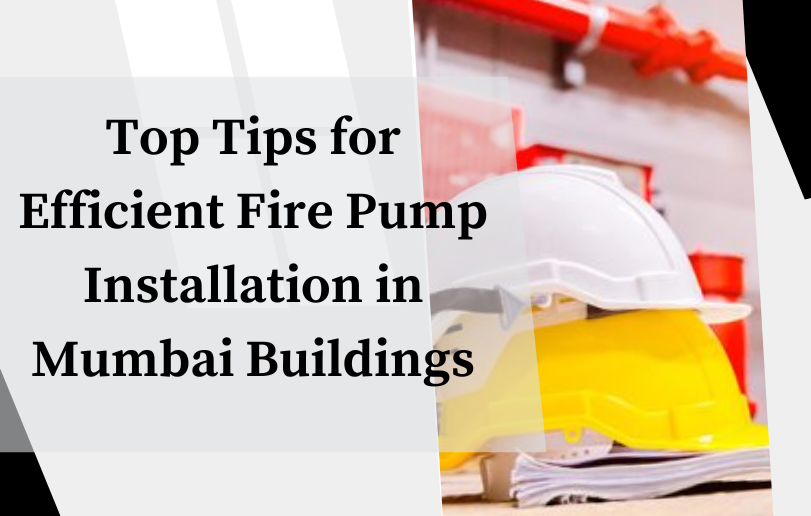Fire safety in high-density urban areas like Mumbai is non-negotiable. With vertical expansion becoming the norm in commercial and residential architecture, fire pumps have become a vital part of the firefighting systems in buildings. At the core of an efficient fire suppression system lies not just the fire pump itself, but how it is installed, maintained, and integrated. In this detailed guide, we share the top tips for efficient fire pump installation in Mumbai buildings to ensure maximum safety and code compliance.
Understanding the Role of Fire Pumps in Mumbai’s High-Rise Buildings
Mumbai’s skyline is dotted with towering structures that rely heavily on fire pumps to maintain adequate water pressure during emergencies. A fire pump system boosts the flow of water from the source (usually a water tank) to the fire suppression systems such as sprinklers or standpipes.
Given Mumbai’s municipal regulations and challenges like fluctuating water pressure and limited infrastructure in older neighborhoods, fire pump installation must be tailored precisely to the building’s structural and safety needs.
1. Conduct a Comprehensive Site Assessment Before Installation
Before the installation of any fire pump, a thorough site evaluation is critical. This includes:
-
Analyzing water supply availability and quality.
-
Checking for space constraints in pump room allocation.
-
Verifying building height and required discharge pressure.
-
Assessing existing fire suppression systems to ensure compatibility.
This step ensures that the chosen pump meets the specific demands of the building and avoids costly modifications down the line.
2. Choose the Right Type of Fire Pump for Your Building
There are several fire pump types commonly used in Mumbai, including:
-
Centrifugal horizontal split-case pumps
-
Vertical turbine pumps
-
End suction pumps
-
Vertical inline pumps
Each has its own advantages. For instance, split-case pumps are ideal for large commercial structures due to their high capacity, whereas vertical inline pumps are perfect for space-constrained locations.
The pump must also comply with NFPA 20 and the Mumbai Fire Brigade regulations.
3. Ensure Adequate Water Supply and Storage
The efficiency of a fire pump is only as good as the water supply feeding it. Mumbai regulations mandate a dedicated fire tank of sufficient capacity based on building use and size.
Key considerations include:
-
Dedicated fire water tanks separate from domestic water tanks.
-
Suction head requirements for the pump—ensure a positive suction head is available.
-
Backup water supply in the form of underground tanks or refillable reserves.
Failure to ensure these could render even a high-quality pump ineffective during a fire emergency.
4. Design a Fully Compliant Fire Pump Room
The fire pump room must adhere to both national and local fire safety standards, including:
-
Adequate ventilation and drainage.
-
Easy accessibility for fire personnel.
-
Fire-rated enclosures to contain fire hazards.
-
Installation of control panels and alarm systems within reach.
Ensure that the layout allows for easy maintenance and testing without compromising operational safety.
5. Integrate with Building Management and Alarm Systems
Modern buildings in Mumbai are moving towards smart fire safety systems. Integrating the fire pump with the Building Management System (BMS) and fire alarm system can automate responses during a fire.
Benefits include:
-
Real-time status monitoring of the fire pump.
-
Automatic start-up in case of sprinkler activation.
-
Remote fault alerts and pump failure diagnostics.
This integration not only enhances safety but also simplifies regular monitoring and maintenance.
6. Install Redundancy and Backup Power Systems
Mumbai’s inconsistent power supply, especially during monsoons, makes backup power for fire pumps essential.
Recommendations include:
-
Diesel engine-driven fire pumps as secondary units.
-
Dedicated power lines for electric pumps.
-
Automatic Transfer Switches (ATS) for seamless switchovers.
-
Battery backup systems for controller panels and alarms.
Having redundancy ensures the pump functions even during city-wide blackouts or grid failures.
7. Use Only ISI-Certified and NFPA-Compliant Components
Quality assurance is paramount. All components, including pipes, controllers, pressure relief valves, and jockey pumps, must be:
-
ISI-certified
-
Compliant with NFPA 20, NBC India, and Mumbai Fire Brigade norms
-
Installed by licensed contractors with fire safety expertise
Avoid generic or non-compliant parts as they may compromise system reliability during an emergency.
8. Conduct Routine Testing and Preventive Maintenance
Installation is just the beginning. An efficient fire pump system demands:
-
Weekly testing to check for readiness.
-
Monthly inspections for mechanical integrity and leaks.
-
Annual third-party audits for compliance.
Maintenance should include lubrication of moving parts, battery health checks, controller functionality tests, and performance benchmarking against manufacturer specifications.
9. Train Your Staff and Occupants
A fire pump is only useful if the building’s occupants know how it works. We recommend:
-
Training building maintenance staff on manual override and troubleshooting.
-
Conducting mock fire drills that incorporate pump activation.
-
Providing visual instruction panels in the fire pump room.
Awareness can make the difference between a manageable fire and a catastrophic one.
10. Work with Certified Fire Pump Installation Experts in Mumbai
Given the complexity and compliance needs in Mumbai, always partner with licensed fire safety professionals. They will ensure:
-
Accurate calculations for flow rate, pressure, and head loss.
-
End-to-end design, supply, installation, and testing.
-
Hassle-free fire department approvals.
Look for vendors with ISO certifications, proven track records in high-rise projects, and a clear understanding of Mumbai Fire Safety Act requirements.
Final Thoughts
Efficient fire pump installation in Mumbai buildings is a life-saving necessity, not just a regulatory checkbox. By choosing the right equipment, ensuring proper integration, and maintaining rigorous safety standards, property managers can safeguard lives and assets effectively. Whether you’re building a new high-rise or retrofitting an older one, prioritizing fire pump efficiency is non-negotiable.
Looking for reliable fire pump installation in Mumbai? Want the best fire fighting contractors in Mumbai to ensure your safety? Choose FTech Enterprises Pvt. Ltd. for expert, compliant, and efficient fire protection solutions tailored to your needs. Get in touch today!
 :
https://in.pinterest.com/ftechenterprisespvtltd/
:
https://in.pinterest.com/ftechenterprisespvtltd/

